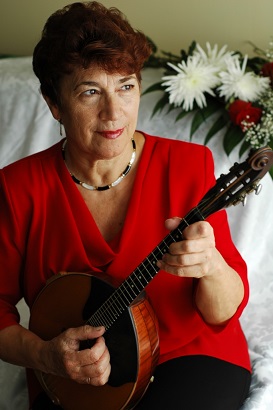Well-known domra player Tamara Volskaya is a Merited Artist of Russia, Laureate of All State and All-Russia competitions, a professor of the Ural State M.P. Mussorgsky Conservatory, a soloist, teacher and theoretician of domra playing. For many years she worked and toured with her husband, bayan player Anatoliy Trofimov, and with pianist Natalia Animitsa and guitarist Vitaliy Derun. Her repertoire consists of original compositions for domra and mandolin, as well as arrangements and transcriptions of violin, piano and symphony orchestra music.
The pieces here are a kind of lifetime collection. They are precious, the “jewels” of her repertoire, and at the same time they evoke a lot of memories about her dear friends and colleagues! These handwritten pieces have been awaiting preparation for publishing for a very long time. T.Volskaya preserved them, edited them and committed them to the computer. She is very grateful to her former student Mayya Kalikhman for finally finishing the work of bringing this collection to the public by putting it on the website!
 G.Handel – J. Halvorsen “Passacaglia” for violin and cello.
G.Handel – J. Halvorsen “Passacaglia” for violin and cello.
This unique arrangement for domra- prima and 4 - string domra – alto was given to T.Volskaya by a wonderful domra-player and teacher from Kiev, Nadezhda Komarova in 1965. The arranger is unknown.
 G.Handel – J. Halvorsen “Passacaglia”. Version for domra and bayan.
G.Handel – J. Halvorsen “Passacaglia”. Version for domra and bayan.
The cello part was masterfully transformed for bayan by Anatoliy Trofimov. He made his arrangement to get an organ-like sound from the bayan. Measures 41-44 differ from the original; they were composed by the arranger.
 E. Kichanov - “Ural Girls’ Round Dance”.
E. Kichanov - “Ural Girls’ Round Dance”.
The original version is for an orchestra of Russian folk instruments. The arrangement for domra and piano was written by the talented Ural musician Arkadiy Zaharov for T.Volskaya, as a mandatory piece for the All State – Russian competition in 1972.
 Three pieces from the ballet “Nutcracker” by P. Tchaikovsky, an original symphony orchestra score. The arrangements for domra and piano were part of a bright domra player Rada Krivenko’s graduation exam at the Ural Conservatory.
Three pieces from the ballet “Nutcracker” by P. Tchaikovsky, an original symphony orchestra score. The arrangements for domra and piano were part of a bright domra player Rada Krivenko’s graduation exam at the Ural Conservatory.
“Adagio”, “March” and “Russian dance” are masterpieces of Tchaikovsky’s music. A.Trofimov created a unique work “to bring to life” for performance these handwritten arrangements.
R.Krivenko wanted to preserve many lines of the score. That’s why the domra and piano parts are very rich and complicated. The pieces are addressed to performers with a very high level of professional skill.
 “Adagio” from ballet “Nutcracker” by Tchaikovsky.
“Adagio” from ballet “Nutcracker” by Tchaikovsky.
Version for domra and bayan. A. Trofimov’s arrangement is based on
R. Krivenko’s piano variant.
 N. Puzey -“ Sonata” for domra and piano.
N. Puzey -“ Sonata” for domra and piano.
The “Sonata” by outstanding Ural composer Nikoly Puzey is one of the best and fundamental original compositions for 4 - string domra. T. Volskaya was the first performer of the composition. The composer wanted to dedicate “Sonata” to the performer later, but “Sonata” wasn’t published yet. T.Volskaya edited the domra part in detail, attracting attention to the use of broad spectrum domra technique to express the very deep emotional state of this great piece.
 N. Puzey -“Poem” for domra and piano.
N. Puzey -“Poem” for domra and piano.
This piece is one of the most dramatic original compositions for domra and piano. “Poem” was first presented by T.Volskaya. She edited the domra part in detail. She considers this piece undervalued and hopes to attract the attention of musicians who will perform it.
 N. Budashkin Concerto for domra 1 mov.
N. Budashkin Concerto for domra 1 mov.
One of the best compositions for domra, the Concerto by N. Budashkin is written for three-string domra with orchestra of Russian folk instruments in g-minor. Transposition in a-minor for four- string domra and editing of piano part were made by T. Volskaya. She also composed a virtuoso cadenza to the concerto. There was another cadenza written by a domra instructor from Kiev, N. A. Pototskaya in the late 1960s. This older version is presented on the last page of the publication.
 M. Zeiger The Thoughts
M. Zeiger The Thoughts
The Thoughts was written for T. Volskaya. She was the initial performer and also the editor of the domra part. In Volskaya’s opinion this piece is unique in domra repertoire: the composer discovered entirely new abilities of the domra as a concert instrument that have not been explored before. The piece consists of six independent movements with individual titles. Each movement is very distinct in structure, dynamics and drama, but all of them are unified by a common idea.

 G.Handel – J. Halvorsen “Passacaglia” for violin and cello.
G.Handel – J. Halvorsen “Passacaglia” for violin and cello.